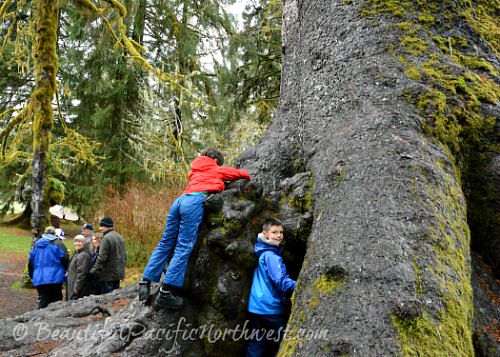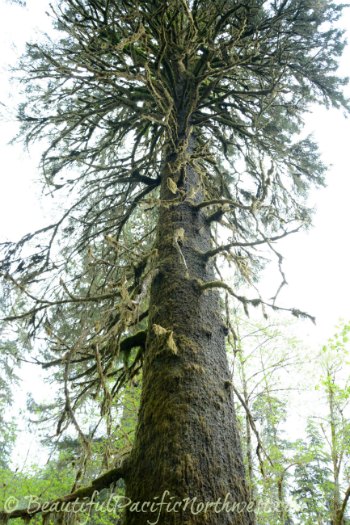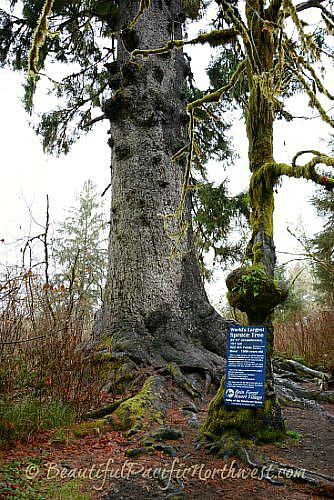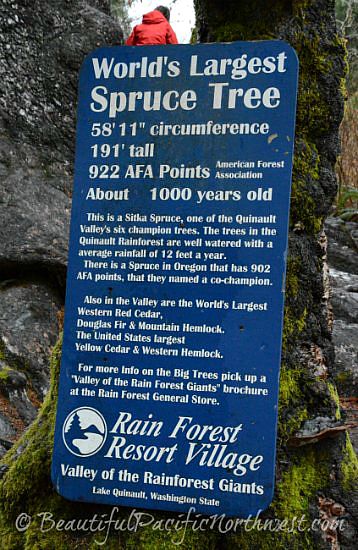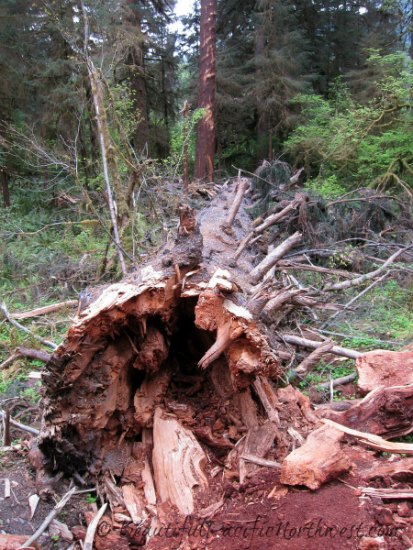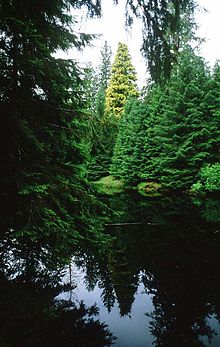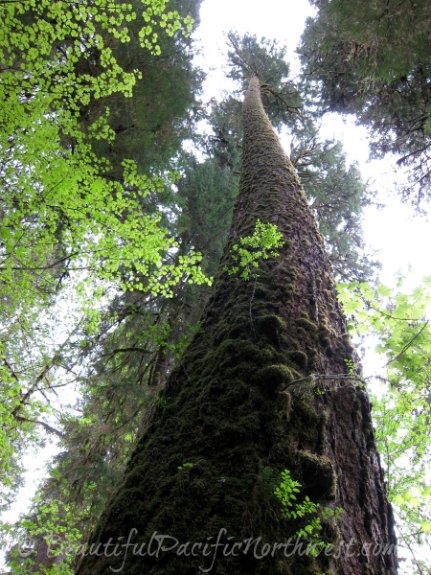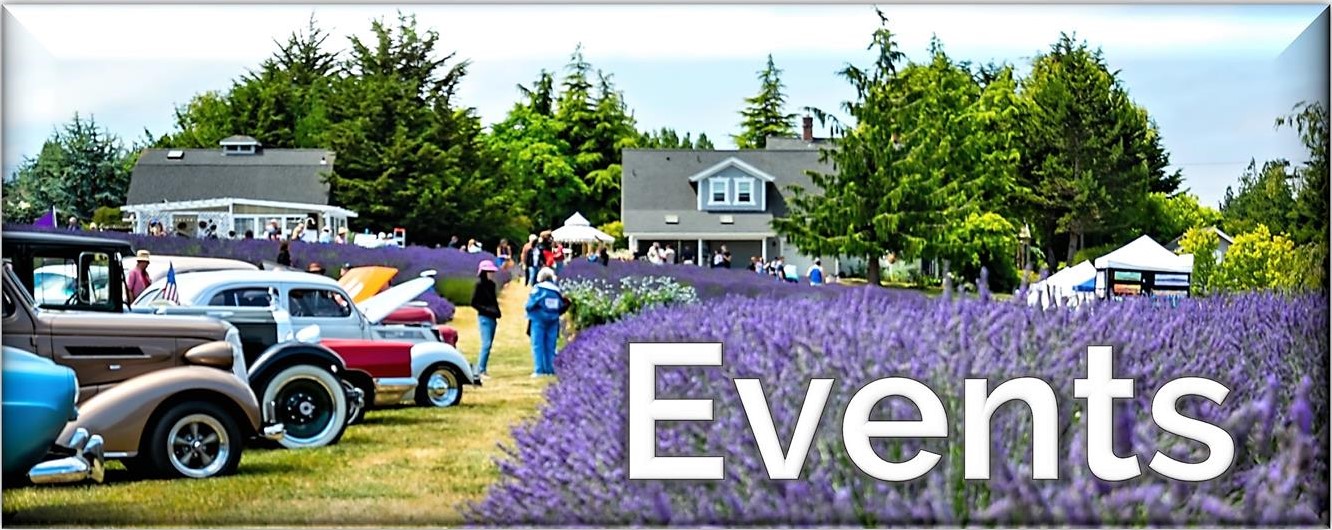Sitka Spruce Tree
Sitka Spruce Tree. Recognize Sitka Spruce in the Pacific Northwest with these photos and descriptions, plus uses for Sitka Spruce.
See the kids playing on the great big tree below? Those are the roots. The roots dwarf the kids while the actual trunk is beyond their reach and soars over their head for 191 feet (58.2 m).
Sitka spruce trees grow to massive sizes. Some have been documented at 300 feet (91.4 m) tall and 15 feet (4.58 m) diameter at breast height (dbh), with a circumference of 58+ feet (17.7 m).
These children are clambering over the roots of the famous Quinault Spruce, located near Lake Quinault in the Olympic National Forest. It has a circumference of 58 feet 11 inches (18 m), and is 191 feet (58.2 m) tall. More photos of this impressive Sitka Spruce below.
Sitka spruce trees can be found in Pacific Northwest coastal rainforest areas where there is plenty of rain and fog to provide the moisture necessary for these trees to rapidly reach their great size.
However, the height of the tree does not necessarily equate with older age. The largest tree, the Queets spruce found along the Queets River in the Olympic National Park, is estimated to only be 350-450 years old, where others have been reported to be upwards of 700 years old. Many of the oldest and largest trees were logged before they could be accurately measured and documented.
Sitka Spruce begin their lives from a one eighth inch (3.25 mm) seed, very tiny for the size of the potential tree contained within.
A young spruce tree begins to produce cones between the age of 15-40, with the seeds ripening in late summer/early autumn.
Recognizing Sitka Spruce Trees
- The bark is nearly gray rather than brown. It is thin and smooth when young, and becomes scaly rather than ridged as it ages. The bark on even the older trees seems more smooth than that of other species found in the Pacific Northwest.
- Needles: According to the revised Plants of the Pacific Northwest Coast (Pojar & MacKinnon), "A quick way to identify Sitka spruce is to grab a branch in your hand: the stiff, sharp needles pointing out on all sides of the branch hurt."
- Cones are reddish and larger than those of Douglas Fir.
Uses for Sitka Spruce Products
Sitka Spruce wood is very strong in relation to its weight. Besides health and nutritional value, it also has excellent acoustic properties. Uses for Sitka Spruce wood include:
- Acoustic instruments such as sounding boards for pianos, violins and guitars
- Airplane, boating, and other components, for example, for light aircraft, plus various components for boats, turbine blades for windmills, even the nose cones of Trident missiles
- Food (and vitamins): The new fresh tips of spruce branches are packed with vitamin C, and can be harvested and eaten fresh off the tree, brewed into a tea or used to make spruce tip syrup and spruce beer.
Make Your Own Spruce Tip Syrup
- Essential oil: Essential oil of Spruce has an earthy/woody/evergreen fragrance and is said to relieve aches and pains, respiratory issues and is considered anti-inflammatory
- The Native Americans use root bark fibers in basket weaving
Sitka Spruce Pests and Threats
Serious pests include the white pine weevil, western hemlock loopers and western blackheaded budworm. It is also susceptible to various forms of rot and rust.
Internal rot, along with a strong wind, causes the demise of many of these formidable trees. This Sitka spruce along the Hoh River succumbed in this way.
History of a Rare Golden Sitka Spruce in BC
On the banks of the Yakoun River in the Haida Gwaii archipelago in British Columbia grew a rare Golden Spruce. A rare genetic mutation caused the tree to grow golden needles which seemed to glow from within in the sunlight. Named Kiidk'yaas, meaning "Ancient Tree" in the Haida language, the golden Sitka Spruce was sacred to the people and central to their culture.
Tragically, in January 1997 in an angry fit of eco-terrorism, an unemployed forestry engineer damaged the 300-year-old tree so severely that it fell within a few days, bringing sorrow to many, especially the Haida people.
A Golden Spruce sapling cultivated from a cutting from the ancient tree was planted at the site in 2001. Read more about Kiidk'yaas here.
Other Giant Sitka Spruce Trees
- Lake Quinault Spruce, Lake Quinault: As pictured and measured above
- San Juan Spruce, San Juan River, Vancouver Island: 12.2 feet (3.72 m) dbh*, 205 feet tall (62.5 m)
- Spruce tree near Seaside, Oregon: 16.7 feet (5.1 m) dbh, 216 feet tall (65.8 m)
- Queets Spruce, Queets River Valley, Olympic National Park: 14.9 feet (4.54 m) dbh, 248 feet tall (75.6 m)
- Carmanah Giant, Carmanah Walbran Provincial Park, Vancouver Island, BC: 314 feet tall (95.7 m), 10 feet (3.05 m) dbh
- 2 Sitka Spruce trees in Prairie Creek Redwoods State Park, Northern California: 316 feet tall (96.3 m) and 317 feet tall (96.6 m)
* dbh = diameter at breast height
This Sitka Spruce pictured at right is not a record-breaker, but it still soars nearly out of sight. Give it a few more years...!
Other links you may enjoy:
What Are Your Favorite Species of Wild Plant Life in This Area?
Tell Us Your Story and Share Your Photos!
Tell Us Your Story and Share Your Photos!
There is an incredible diversity and amazing array of beauty found in the Pacific Northwest flora! In this region, wild plant life can present as ancient giants, microscopic wonders, intoxicatingly fragrant, some edible, healing, others quite poisonous. Splashes of brilliant in color, or shrouded and mysterious, each one, amazing in its uniqueness...
Do you have a great story about the wild plant life found in the Olympic National Park? We'd love to hear about it and please share your photos as well! Just click into the title box below and go from there. When published, you'll have "your own" page on MyPortAngeles which you can share with friends or anyone who asks!
We're happy to ensure professional and amateur photographers get credit for their work. Leave us your name in the form below, and means of contact, website, or FB page info so we can link back to you.
